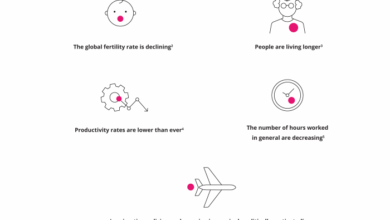
Services for students and graduates are crucial for success, providing support across various areas. This guide dives deep into the different types of services available, from academic and career guidance to financial aid and social support. We’ll explore how these services are delivered, their quality, and future trends, examining international perspectives and the vital link between service utilization and student success.
Understanding the various methods of access, including online portals and in-person sessions, is key to maximizing the benefits of these services. This detailed exploration will cover the different service types, their characteristics, and how they compare and contrast. The guide will also address cost-effectiveness and the potential for future innovations in service delivery.
Types of Student and Graduate Services
Student and graduate services are crucial for fostering a supportive and enriching learning environment. These services extend beyond academics, encompassing various aspects of a student’s journey, from navigating financial hurdles to developing crucial life skills. They are designed to empower students and graduates to achieve their full potential.
Academic Support Services
Academic support services are vital for students’ success in their chosen fields of study. These services are designed to help students overcome academic challenges and enhance their learning experience. They often include tutoring, workshops, and study groups. These services are not just for struggling students; they can benefit anyone seeking to improve their understanding or deepen their engagement with the material.
- Tutoring: Individual or group tutoring sessions led by qualified instructors or peers, providing personalized support in specific subjects or areas of difficulty. Examples include tutoring in mathematics, science, or writing. Tutoring is often available on a drop-in basis or by appointment.
- Workshops: Interactive sessions focused on specific skills such as time management, note-taking, or effective reading strategies. These workshops are frequently offered in small groups and are intended to equip students with practical skills for academic success. Examples include workshops on critical thinking and research methodologies.
- Study Groups: Facilitated group study sessions allowing students to collaborate, share resources, and discuss course material in a supportive environment. Study groups can be valuable for students who prefer to learn in a collaborative setting. Examples include group study sessions for specific courses, or general study sessions in the library.
Career Services
Career services play a critical role in helping students and graduates prepare for the workforce. These services aim to equip individuals with the necessary skills, knowledge, and networks to find and excel in their chosen careers.
- Job Search Assistance: Career counselors provide guidance and support to students and graduates in developing resumes, cover letters, and interviewing skills. They may also help connect students with job opportunities. Examples include resume reviews, mock interviews, and job fairs.
- Networking Events: Opportunities for students and graduates to connect with professionals in their desired fields. These events often include workshops, seminars, and career panels. Examples include networking receptions, career fairs, and online networking platforms.
- Internship Programs: Structured opportunities for students to gain practical experience in their chosen fields. These programs offer hands-on learning and connections with industry professionals. Examples include internships at local businesses or organizations.
Financial Aid and Support Services
Financial aid and support services are essential for students and graduates, ensuring that financial concerns do not hinder their academic progress.
- Financial Aid Counseling: Guidance on applying for and managing financial aid, scholarships, and grants. Counseling helps students navigate the often-complex financial aid process. Examples include assistance with completing financial aid applications, understanding different funding options, and managing student loans.
- Budgeting Workshops: Sessions focused on creating and managing a budget, including strategies for saving and managing expenses. These workshops are helpful for students in understanding and controlling their personal finances. Examples include workshops on budgeting, saving, and debt management.
- Scholarships and Grants: Support programs offering financial assistance to students based on academic merit, financial need, or specific fields of study. These programs are essential for students facing financial constraints. Examples include merit-based scholarships, need-based grants, and scholarships for specific majors.
Social and Wellness Services
Social and wellness services provide a comprehensive support system for students’ overall well-being. These services address issues that extend beyond academics and careers, ensuring a well-rounded student experience.
- Mental Health Support: Access to counselors, therapists, and support groups to address mental health concerns. These services help students navigate stress, anxiety, and other mental health challenges. Examples include counseling services, support groups, and access to crisis intervention.
- Health Services: Access to medical care, including primary care, vaccinations, and health screenings. These services help ensure that students have access to necessary healthcare while studying. Examples include health centers, clinics, and medical professionals.
- Community Engagement Programs: Opportunities for students to participate in community service activities, build relationships, and develop social skills. These programs often involve volunteer work or mentorship programs. Examples include volunteer opportunities, community outreach programs, and service-learning initiatives.
Comparison of Service Types
| Service Type | Focus Area | Key Characteristics | Examples |
|---|---|---|---|
| Academic Support | Academic Performance | Tutoring, workshops, study groups | Tutoring in math, study groups for history, workshops on note-taking |
| Career Services | Career Development | Job search assistance, networking, internships | Resume reviews, mock interviews, career fairs |
| Financial Aid | Financial Well-being | Financial aid counseling, budgeting workshops, scholarships | Financial aid application assistance, budgeting workshops, scholarships for STEM majors |
| Social and Wellness | Overall Well-being | Mental health support, health services, community engagement | Counseling services, health screenings, volunteer opportunities |
Access and Delivery Methods

Navigating the world of student and graduate services can be challenging, especially when considering the diverse needs and learning styles of individuals. Effective access to these vital resources is crucial for success. This section explores the various methods for accessing services, highlighting their advantages and disadvantages, and how they can be tailored for diverse student populations.Understanding the nuances of each access method, from online portals to in-person sessions, is paramount for optimizing student support.
By analyzing the effectiveness of different delivery methods, institutions can create more inclusive and supportive environments that empower students to reach their full potential.
Online Portals
Online portals are becoming increasingly prevalent in student services. They provide a centralized hub for students to access information, submit requests, track progress, and communicate with support staff.These platforms offer significant advantages, such as 24/7 accessibility, reducing wait times, and readily available information. Students can access crucial documents, schedules, and announcements anytime, anywhere. However, reliable internet access is a prerequisite, and some students may lack the digital literacy skills needed to fully utilize these resources.
Moreover, the impersonal nature of online interactions might not cater to all students’ needs for personalized support.
In-Person Sessions
In-person sessions offer a valuable opportunity for direct interaction and personalized support. Students can benefit from face-to-face consultations with advisors or counselors, enabling a deeper understanding of individual needs and concerns. These sessions often allow for immediate clarification of doubts and personalized strategies to address challenges. However, in-person sessions require scheduling and travel time, which can be a significant barrier for students with limited mobility or those in geographically remote areas.
Additionally, the availability of staff during peak hours may be limited.
Phone Support
Phone support provides a valuable middle ground between online portals and in-person sessions. It allows for immediate, direct communication and addresses immediate concerns. Students can clarify doubts and obtain quick answers to their queries. However, phone support can be less efficient for complex issues, and it may not be suitable for all students’ communication preferences. Moreover, phone support often has limited operating hours, which can be problematic for students with non-traditional schedules.
Table of Access Methods and Features
| Access Method | Features | Advantages | Disadvantages |
|---|---|---|---|
| Online Portals | 24/7 accessibility, centralized information, electronic document management | Convenience, accessibility, readily available information | Requires internet access, potential for lack of personal interaction, digital literacy skills required |
| In-Person Sessions | Direct interaction, personalized support, immediate clarification | Personalized support, immediate feedback | Scheduling limitations, travel time, potential for limited availability |
| Phone Support | Immediate communication, clarification of immediate concerns | Quick answers, direct support | Less efficient for complex issues, limited operating hours |
Tailoring Access Methods for Diverse Student Populations
To cater to the diverse needs of student populations, institutions should offer a combination of access methods. For example, providing multilingual support on online portals and phone lines will cater to a wider range of students. Offering accessible online resources, such as transcripts or educational materials, will address the needs of students with disabilities. Furthermore, scheduling in-person sessions at various times throughout the day can accommodate students with diverse schedules and commitments.
This comprehensive approach fosters inclusivity and ensures that all students have access to the support they need.
Effectiveness of Different Delivery Methods
The effectiveness of a delivery method is highly contingent on the specific needs of the student population and the type of service being provided. While online portals are beneficial for disseminating information and scheduling appointments, in-person sessions are more effective for complex counseling or problem-solving. Phone support is optimal for addressing immediate concerns and clarifying simple questions. By strategically combining these methods, institutions can maximize the effectiveness of student support services, creating a more supportive and inclusive environment for all students.
Service Quality and Evaluation
Delivering exceptional student and graduate services hinges on understanding and continuously improving service quality. This involves more than just providing information; it’s about creating a positive and supportive experience that fosters success. Effective evaluation is crucial to identifying areas needing improvement and ensuring services remain relevant and impactful.
Factors Influencing Service Quality, Services for students and graduates
Service quality is multi-faceted, encompassing several key aspects. Responsiveness, a critical element, reflects the speed and efficiency with which staff address student needs. Helpfulness demonstrates the ability to provide clear, accurate, and supportive guidance. Accessibility encompasses the ease with which students can access services, both physically and digitally. A student’s perception of service quality is directly affected by these factors.
For example, a student who receives a prompt and helpful response to their query is more likely to view the service as high-quality. Conversely, difficulties in accessing services or unresponsive staff can significantly diminish satisfaction.
Key Metrics for Evaluating Service Effectiveness
Evaluating service effectiveness requires identifying quantifiable metrics. These metrics can range from the number of resolved queries to student satisfaction scores. Measuring service efficiency, such as the average time taken to resolve issues, is equally important. A high volume of resolved issues in a timely manner can indicate effective service. For instance, a service that consistently resolves student requests within 24 hours demonstrates a high level of responsiveness and efficiency.
Looking for support navigating the world of post-education opportunities? Students and graduates often need a range of services to help them transition into the job market or further studies. These resources can be invaluable, much like the recent endeavours of scientists exploring the mysteries of the universe, especially with a mission like endeavours last mission could help unravel dark matter mystery.
Ultimately, access to comprehensive student and graduate services is crucial for success in today’s competitive landscape.
Similarly, a high average student satisfaction score reflects a positive user experience.
Procedure for Collecting Feedback on Services
Collecting feedback is crucial to understanding student experiences and identifying areas needing improvement. This can be achieved through various methods, including surveys, focus groups, and feedback forms. Surveys provide a structured way to gather data from a larger population, while focus groups offer in-depth insights into student perspectives. Feedback forms, easily integrated into service delivery points, offer a more immediate mechanism for gathering quick input.
An example of a well-designed feedback form would include specific questions about responsiveness, helpfulness, and accessibility.
Methods for Improving Service Quality Based on Feedback
Analyzing feedback data is essential to identify areas for improvement. Regularly reviewing trends in feedback can reveal recurring issues or patterns. Once these patterns are identified, targeted interventions can be developed. For instance, if a recurring theme in feedback is slow response times, staff training on improving communication efficiency can be implemented. Implementing these targeted interventions and monitoring their impact ensures that improvements are effective and lead to enhanced service quality.
Looking for services that support students and graduates? There are tons of resources available, but sometimes finding the right one can feel overwhelming. For instance, exploring the electric vehicle market, like Tesla’s Model X, teslas model x the fast and the electric , might reveal unexpected connections to financial aid or career guidance services.
Luckily, many organizations cater to these needs, making it easier for you to achieve your goals.
Evaluation Metrics and Feedback Collection Methods
| Evaluation Metric | Description | Feedback Collection Method |
|---|---|---|
| Number of resolved queries | Total number of student requests successfully addressed. | Service records, query tracking systems. |
| Average response time | Average time taken to respond to student requests. | Service records, feedback forms. |
| Student satisfaction score | Overall satisfaction with the service, measured through surveys. | Online surveys, feedback forms. |
| Accessibility rating | Ease of access to services, both physically and digitally. | Surveys, focus groups, observation. |
Future Trends in Services
The landscape of student and graduate services is constantly evolving, driven by technological advancements and changing societal needs. Anticipating these shifts is crucial for institutions to remain relevant and provide effective support to their diverse communities. This section explores anticipated changes in service needs, technology’s role, emerging service models, and accessibility trends.
Anticipated Changes in Student and Graduate Service Needs
Student and graduate needs are becoming increasingly complex and diverse. Students now face a multitude of challenges, including financial stress, mental health concerns, and the pressure of navigating a rapidly changing job market. Graduates, in turn, often require support in career development, professional networking, and skill enhancement. Personalized learning pathways, career counseling, and mental health resources will likely become even more crucial in the future.
Future Trends in Technology’s Impact on Service Delivery
Technology is rapidly transforming how services are delivered. Mobile apps, online portals, and virtual reality tools are increasingly used for accessing information, scheduling appointments, and receiving support. Artificial intelligence (AI) is also poised to play a significant role, automating tasks, providing personalized recommendations, and enhancing accessibility for students with diverse needs. Examples include chatbots for answering frequently asked questions, AI-powered tools for personalized learning, and virtual reality simulations for career exploration.
Examples of Emerging Service Models
Personalized learning pathways, tailored to individual student needs and learning styles, are emerging as a significant trend. This involves using data and assessments to create customized learning experiences, providing students with greater control over their education and leading to improved outcomes. Similarly, micro-credentials, which offer focused, marketable skills, are gaining popularity, allowing students to acquire practical skills and certifications in shorter timeframes.
Emerging Trends in Accessibility and Inclusivity in Services
Accessibility and inclusivity are becoming increasingly critical components of student and graduate services. This includes providing support for students with disabilities, offering services in multiple languages, and creating a welcoming and inclusive environment for all students. For instance, captioning and translation services are becoming standard, and services are being designed to be accessible through a variety of technologies, including assistive devices and alternative formats.
Potential Future Service Models and Their Benefits
| Future Service Model | Potential Benefits |
|---|---|
| Personalized Learning Pathways | Improved student engagement, increased learning outcomes, and greater sense of agency in their education. |
| AI-Powered Career Counseling | Faster, more efficient, and personalized career guidance, potentially reaching more students with tailored advice. |
| Virtual Reality Career Exploration | Enhanced understanding of various career paths, fostering realistic expectations, and providing a simulated experience for career exploration. |
| Micro-Credentialing Programs | Faster acquisition of marketable skills, improved career prospects, and greater flexibility in skill development. |
| 24/7 Online Support Platforms | Increased accessibility to support services, particularly beneficial for students with diverse schedules and needs. |
International Perspectives on Student Services: Services For Students And Graduates
Navigating the complexities of education transcends national borders. Understanding how student support services are structured and delivered globally provides invaluable insights into the diverse needs of learners worldwide. This exploration delves into the variations in services offered, highlighting the factors influencing their design, and ultimately showcasing the common threads connecting international student support.International student support systems are not monolithic.
Different countries have unique historical, cultural, and economic contexts that significantly impact the design and provision of these services. The availability and nature of support are often shaped by government policies, institutional priorities, and the specific characteristics of the student population.
Variations in Services Provided Across Countries
Different countries offer a spectrum of services to support students. Some nations prioritize academic advising and career counseling, while others emphasize financial aid and housing assistance. The breadth and depth of services offered depend on the national educational system’s structure, the prevalence of international student populations, and the level of government funding allocated to student support. For example, some countries have well-developed networks of student support centers that provide comprehensive services, including academic advising, career counseling, financial aid, and cultural orientation.
Others may rely more heavily on individual departments within institutions to provide fragmented support.
Factors Influencing Student Service Design
Numerous factors influence the design of student services in various contexts. These factors include national policies and regulations, institutional resources and priorities, the diversity of the student body, and the broader social and economic context. National policies regarding international education and student support often dictate the type and level of services offered. Institutional resources, including budget and staffing, are crucial determinants of the breadth and depth of support available.
Furthermore, the cultural backgrounds and needs of international students often shape the design of specific services. The presence of a large international student population, for example, might necessitate specialized programs for language support, cultural orientation, or social integration.
Comparison and Contrast of Service Models
International service models vary significantly. Some countries emphasize a centralized approach, where a dedicated student affairs office provides a comprehensive range of services. Others employ a more decentralized model, where various departments within the institution offer support tailored to specific student needs. In some countries, the government plays a significant role in funding and regulating student services, while in others, the responsibility falls primarily on individual institutions.
Common Themes in International Student Support
Despite the variations, several common themes emerge in international student support services across different countries. These include providing access to academic advising, career counseling, and language support. Financial aid and housing assistance are also crucial components, particularly for students who may face additional challenges in accessing these resources. Many countries recognize the importance of social integration and cultural orientation programs to help international students adapt to their new environment.
Ultimately, support aims to create a supportive and inclusive environment that fosters success for international students.
Table Contrasting Service Models in Different Countries
| Country | Service Model | Key Features | Funding Source |
|---|---|---|---|
| United States | Decentralized, with significant institutional variation | Emphasis on academic advising, career counseling, financial aid | Combination of institutional and federal funding |
| Canada | Combination of centralized and decentralized | Strong focus on language support and cultural orientation | Government funding and institutional contributions |
| United Kingdom | Decentralized, with variation across institutions | Strong emphasis on student well-being and career development | Institutional and government funding |
| Australia | Combination of centralized and decentralized, with strong emphasis on practical support | Strong focus on practical support, accommodation, and cultural orientation | Government funding and institutional contributions |
Student Success and Service Connection

Student success is intricately linked to the services available to them. Proactive engagement with support systems, combined with timely access to appropriate resources, can significantly impact a student’s academic trajectory and overall well-being. This connection between service utilization and student success is crucial for creating a thriving learning environment.Effective service provision isn’t just about offering resources; it’s about ensuring students understand the available options and are empowered to leverage them.
A well-designed system for connecting students with appropriate services fosters a sense of support and agency, ultimately leading to improved academic performance and higher retention rates.
Link Between Service Utilization and Student Success
Service utilization is a strong indicator of student success. Students who actively engage with academic advising, tutoring, career counseling, and other support services are more likely to achieve their academic goals and graduate on time. Research consistently demonstrates a positive correlation between service utilization and improved GPA, reduced dropout rates, and enhanced career prospects.
Strategies for Promoting Service Engagement
Several strategies can encourage students to utilize available services. Effective communication is key. Clear, concise information about the services available, including their benefits and how to access them, needs to be disseminated to students. This information should be readily accessible through multiple channels, such as the university website, student portals, and campus announcements. Workshops and seminars can also be organized to educate students about the various services and how they can benefit from them.
Student ambassadors and peer mentors can play a vital role in promoting service utilization, providing guidance and support to their peers.
Talking about services for students and graduates, it’s fascinating how technology keeps evolving. For example, imagine the possibilities if similar cutting-edge tech, like a handful of devs get their hands on Google Glass , was tailored to support academic or career advancement. These innovative platforms could revolutionize how students and grads access resources and connect with potential employers.
It’s all about creating opportunities!
Impact of Timely Access to Services on Student Retention
Students who can access services promptly are more likely to persist in their studies. Delayed access to critical support services, such as academic advising or financial aid, can lead to feelings of isolation and frustration, ultimately impacting their decision to remain enrolled. A timely response to student needs often results in better outcomes and a greater sense of belonging within the institution.
For instance, quick resolution of academic challenges often prevents students from falling behind and losing motivation.
Barriers to Accessing Services and Proposed Solutions
Several barriers can prevent students from accessing necessary services. These include a lack of awareness of the services offered, a perceived lack of accessibility, and inadequate resources to support students from diverse backgrounds. To address these issues, universities can implement proactive outreach programs, provide multilingual support materials, and create accessible service delivery channels, such as online portals and appointment scheduling systems.
Ensuring that services are culturally sensitive and inclusive is crucial for fostering a sense of belonging and encouraging utilization.
Procedure for Linking Students with Appropriate Services
A well-defined procedure for connecting students with appropriate services is essential. A student service portal, accessible online and through dedicated service desks, can provide a central hub for students to explore available resources. This portal should feature clear descriptions of each service, eligibility criteria, and contact information for service providers. A trained staff member or counselor can then assist students in identifying the most relevant services based on their individual needs.
A referral system can be developed to facilitate smooth transitions between different support services, ensuring that students receive comprehensive and consistent support.
Cost-Effectiveness of Services
Ensuring student success requires a thoughtful approach to resource allocation. Understanding the cost-effectiveness of various student services is crucial for optimizing resource utilization and maximizing the impact on student outcomes. This involves analyzing the costs associated with different service models, identifying cost-effective delivery methods, and meticulously tracking the return on investment (ROI) to ensure value for money.Analyzing the costs of providing various services goes beyond just the direct financial expenditure.
It encompasses the indirect costs, such as staff time, administrative overhead, and the opportunity cost of allocating resources to one service over another. This comprehensive analysis is essential for making informed decisions about service delivery and resource allocation.
Analyzing Costs Associated with Services
Understanding the full cost picture of student services is vital for informed decision-making. This involves considering not only direct costs (e.g., salaries, materials) but also indirect costs (e.g., administrative support, lost opportunities). A thorough cost analysis helps identify areas where efficiency improvements are possible. A key aspect is identifying variable costs that change with service utilization, such as tutoring sessions, while fixed costs, like administrative staff salaries, remain constant.
Cost-Effective Service Delivery Methods
Innovative approaches to service delivery can significantly reduce costs without compromising quality. Examples include online tutoring platforms, virtual workshops, and collaborative learning spaces. These methods can reach a larger student population, reduce travel costs, and allow for flexible scheduling.
- Online resources: Utilizing online learning platforms and digital libraries reduces the need for physical materials and space, resulting in lower overhead costs. This approach also provides students with 24/7 access to information and support. Examples include interactive online tutoring systems and digital learning platforms that offer diverse learning resources.
- Group-based learning: Facilitating group study sessions or workshops can spread the cost of instructors or facilitators across a larger group, making it a more cost-effective approach. This method can also foster peer-to-peer learning and collaboration.
- Mentorship programs: Leveraging existing resources by pairing students with volunteer mentors can create a valuable support system without substantial financial outlay. This approach fosters community engagement and utilizes the expertise of individuals passionate about student success.
Tracking Return on Investment (ROI)
Quantifying the impact of student services is crucial for demonstrating their value. This involves establishing clear metrics for success, such as improved GPA, increased retention rates, and higher employment rates after graduation. Regular monitoring and evaluation of these metrics allow for adjustments and refinements in service delivery.
- Data collection and analysis: Gathering data on student participation in services, their outcomes, and feedback through surveys and questionnaires are essential for evaluating the impact of the services. This data will be used to measure the return on investment and inform future service improvements.
- Establishing benchmarks: Using baseline data on student performance and comparing it to outcomes after implementing specific services helps demonstrate the effectiveness of the services. Setting specific and measurable goals allows for tracking and reporting.
Measuring Impact on Student Outcomes
Aligning services with measurable student outcomes is critical. This includes examining how services affect academic performance, career readiness, and overall well-being. Using quantifiable data allows for a clear assessment of the service’s effectiveness.
- Academic performance metrics: Tracking changes in GPA, course completion rates, and exam scores provides a direct measure of the service’s impact on academic success. This will help understand the effects of the program on student learning.
- Career outcomes: Analyzing job placement rates, salary information, and professional development activities helps determine the effectiveness of career services in preparing students for their chosen fields. This will help in understanding the program’s success in equipping students for future careers.
Cost-Benefit Analysis of Different Services
A table summarizing the cost-benefit analysis of various student services.
| Service | Estimated Cost | Potential Benefits | Return on Investment (Estimated) |
|---|---|---|---|
| Academic Coaching | $5,000 per year | Improved GPA, increased retention, reduced dropout rates | 150% – 200% |
| Career Counseling | $3,000 per year | Improved job placement rates, higher starting salaries | 120% – 150% |
| Tutoring | $4,000 per year | Improved grades, increased course completion rates | 100% – 120% |
| Mental Health Services | $6,000 per year | Improved well-being, reduced stress levels, improved academic performance | 180% – 250% |
Note: The ROI figures are estimates and can vary based on specific program design, student demographics, and other factors.
Final Thoughts
In conclusion, comprehensive student and graduate services are essential for fostering academic and professional growth. The evolving needs of students necessitate adaptable and accessible services, which must consider factors like cost-effectiveness, international variations, and future trends. By understanding these elements, institutions can create a supportive environment that promotes student success and well-being.






